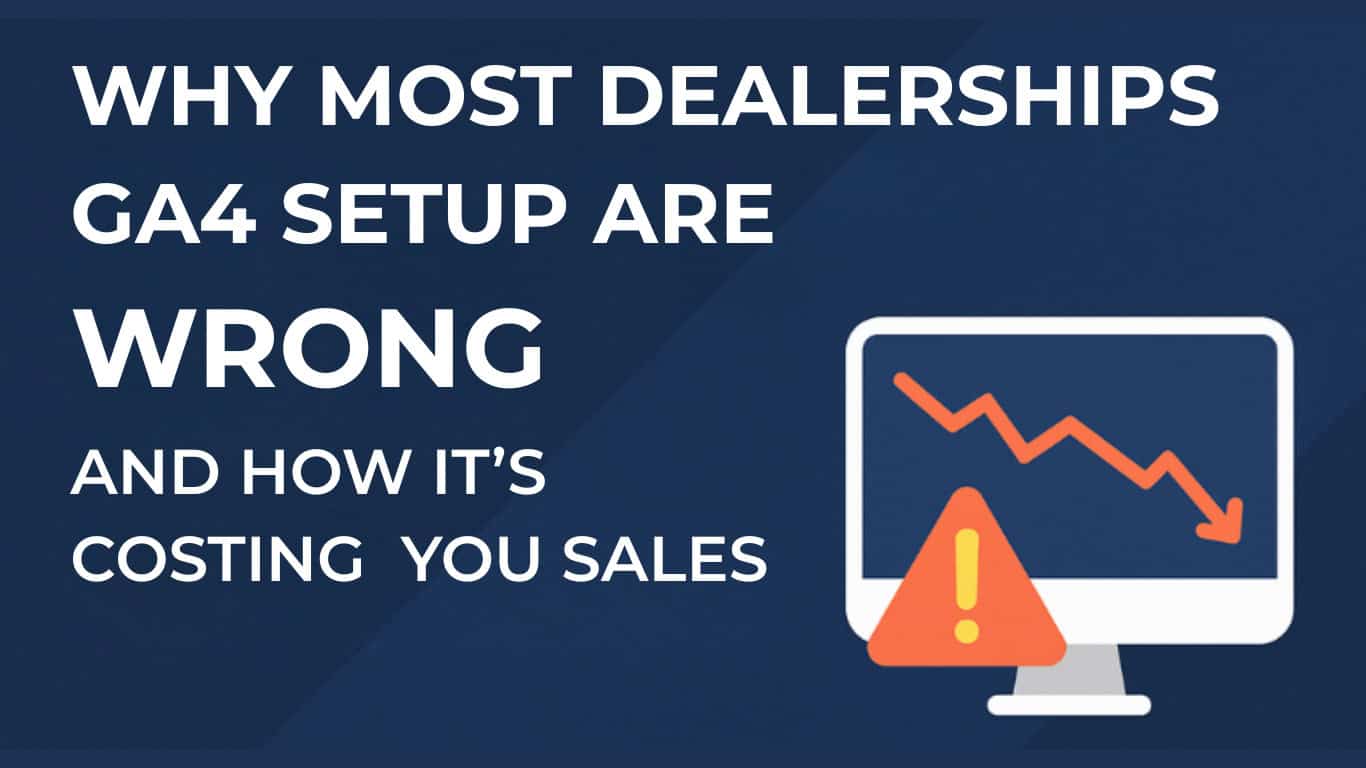Let’s cut to the chase — most automotive dealerships’ GA4 setups are a complete hot mess. That’s not exaggeration; it’s reality. After auditing hundreds of dealership GA4 properties, I have yet to find a single one set up correctly right out of the gate.
Why? Because most dealers rely on their website provider or ad agency to handle the setup. Those setups are almost always designed to make the vendor’s performance look better, not to give the dealer accurate, actionable data they can actually use.
Even worse, these providers rarely (if ever) contact every third-party vendor — from chat tools to digital retailing platforms to service schedulers — to ensure their events are firing correctly into GA4. And when a dealership adds a new tool, updates their website, or changes vendors, the GA4 configuration is almost never updated to reflect those changes.
The result? Critical events go missing, data gaps grow over time, and the dealership is left with incomplete, misleading reports — filled with bad data, inflated performance metrics, and numbers that hide the truth about what’s actually driving (or not driving) leads and sales.
In this blog, we’ll break down the most common GA4 mistakes, show how they’re costing your dealership money every single month, and explain how to fix them so you can finally trust your data — and hold your vendors accountable.
The Shift to GA4 — And Why It’s Not a Simple Upgrade
When Google sunsetted Universal Analytics (UA) and forced the transition to GA4, it wasn’t just a software update — it was a complete shift in how data is collected, stored, and reported. Dealerships were promised better cross-platform tracking, enhanced event-based data, and more customization options.
But with that flexibility came complexity, and most setups were rushed through without fully understanding automotive-specific needs. The result? Bad data, inflated reporting, and incomplete tracking.
The Top 5 GA4 Mistakes Hurting Dealerships
1. Events Are Not Aligned with ASC Standards
The Automotive Standards Council (ASC) has defined specific events and naming conventions for dealership GA4 setups — covering everything from VDP views to lead form submissions.
Most setups I see are missing key events, improperly labeled, or duplicating data, making it nearly impossible to tell:
- Which actions actually lead to sales
- Which marketing channels drive meaningful engagement
🔍 Example: Instead of seeing a clean, ASC-compliant asc_form_submission event with a clear event owner (showing which vendor, tool, or source generated the lead), you might just see a generic form_submit event — leaving you with no way to know which company, platform, or campaign actually drove the lead.
2. Why custom dimensions Are Critical for Accurate GA4 Reporting in Dealerships
Without custom dimensions, GA4 is practically useless for car dealers. Out of the box, GA4 tracks basic website interactions, but it has no context about your inventory, lead sources, or which vendor triggered an event. That context comes from custom dimensions and custom metrics — and without them, your reports are incomplete at best and misleading at worst.
What custom dimensions Track
In a properly configured GA4 property (like the ones we set up), custom dimensions capture every piece of critical data you need to understand customer behavior, vendor performance, and campaign effectiveness. Examples include:
✅ Vehicle Data: Make, model, trim, year, condition, fuel type
✅ Lead & Form Data: Form type, form name, department (sales vs service), event owner (which vendor triggered the event)
✅ Engagement Data: Element text, element color, element position — capturing what users clicked, hovered over, or engaged with
✅ Vendor Attribution: Every tracked event includes an event owner, so you know exactly which tool (chat, trade tool, digital retailing platform) triggered it — ensuring vendors can’t inflate their value with misleading data
Why It Matters
Without these custom dimensions, your GA4 reports can’t:
✅ Connect leads back to specific inventory, forms, or offers
✅ Distinguish sales leads from service leads
✅ Identify which vendors are actually contributing to lead generation
✅ Track how users engage with specials, buttons, and CTAs
✅ Accurately measure which tools and pages drive high-intent actions
🚨 Bottom line: GA4 is just raw data without these definitions. If your dealership’s GA4 reports are confusing, incomplete, or inflated, there’s a very good chance your custom dimensions weren’t set up — or vendors aren’t firing their events correctly into your property.
3. Critical Events Are Incomplete or Missing — Leaving Gaps in the Customer Journey
Tracking inventory views and form submissions is important, but in today’s digital-first environment, it’s nowhere near enough. Modern dealership websites are interactive platforms, with shoppers bouncing between VDPs, chat tools, service schedulers, special offers, digital retailing tools, and more.
To truly understand what’s driving leads, appointments, and sales, you need to capture every meaningful customer interaction — across every tool and platform on your site.
A properly configured, ASC-compliant GA4 property tracks:
✅ Every click, hover, and swipe — so you know which CTAs and offers customers engage with
✅ Form interactions — including form starts, completions, and drop-offs
✅ Chat launches and interactions — including which page the chat was triggered from
✅ Service scheduler clicks and form submissions
✅ Digital retailing tool engagement — including start, progress, and abandonment points
✅ Special offer views and clicks
Why It Matters
Without this level of tracking, you’re left guessing:
❓ Which tools actually move shoppers closer to purchase?
❓ Where are customers abandoning — and why?
❓ Which CTAs, specials, and offers drive real engagement?
❓ Are vendors firing all required events — and are they doing it correctly?
This granular tracking powers:
✅ A/B testing — See which page layouts, buttons, and offers drive better engagement
✅ Smarter retargeting — Build audiences from high-intent actions, not just page views
✅ True vendor accountability — Know which tools and providers actually contribute to conversions
🚨 Bottom line: If your GA4 isn’t capturing every key interaction — including chat, service scheduling, DR, and specials — you’re missing critical insights and making decisions based on incomplete data.
4. Poor Integration with Google Ads & GBP
GA4 doesn’t exist in a vacuum — it should be seamlessly integrated with:
- Google Ads (for audience building and conversion optimization)
- Google Business Profile (GBP) (for local visibility and lead tracking)
- Other platforms you rely on for marketing and reporting.
When Integration Fails
🤷♂️ You waste ad spend targeting the wrong people.
🤷♂️ You underreport conversions, making some vendors look more effective than they actually are.
🤷♂️ You lose visibility into which channels drive real ROI.
5. Misconfigured Conversion Tracking — Inflating Performance and Hiding Problems
Even when a website provider or agency sets up a dealership’s GA4 property, it’s rarely done correctly.
The Real Issue
Vendors often misconfigure key events (formerly conversions), inflating performance by counting:
- VDP and SRP views
- Image clicks
- Form opens or chat engagements (instead of actual submissions)
This makes vendors look like they’re delivering more leads and quality traffic than they really are — masking the difference between casual shoppers and true purchase intent.
Ownership Problems
To make matters worse, dealers often don’t even own their GA4 property. Instead:
- The website provider or agency owns the property, locking dealers out.
- Dealers must request changes through the vendor, which are often ignored.
- Many dealers end up having to create a new GA4 property, losing historical data in the process.
🚨 Bottom line: If you don’t own your GA4 property, you don’t own your data — and if you can’t trust your data, you can’t trust your reports.
How Bad GA4 Data Directly Costs Dealerships Money
Every bad decision driven by bad data adds up:
- 💸 Wasted Ad Spend — Targeting the wrong inventory or audience
- 📉 Missed Leads — Due to incomplete event tracking or broken forms
- 📊 Inflated Vendor Reports — Making vendors look better than reality
- 🚪 Lost Sales Opportunities — When you can’t connect digital activity to real sales
🚨 A dealership’s data should be its biggest asset — but for many, it’s a liability.
How to Fix It — The BZ Consultants Process
At BZ Consultants Group, we don’t just “clean up” your GA4 — we build a data foundation your dealership owns and controls.
Our Process
✅ Revise all settings, custom dimensions, and key events to match ASC standards.
✅ Ensure custom dimensions track everything that matters — not just vehicles, but forms, lead sources, chat engagements, service interactions, specials, and more.
✅ Define conversions (key events) that represent actual lead-generating actions, not just passive engagements.
✅ Work directly with every vendor — website providers, chat tools, DR platforms, service schedulers — to ensure they fire ASC events correctly into a dealer-owned GA4 property.
✅ Ensure Google Ads, GBP, and other platforms receive clean, accurate data.
✅ Hold vendors accountable — based on data you control, not them.
🚨 This isn’t a quick fix. Full audits, corrections, and vendor coordination typically take 60-90 days — but that’s what it takes to fix years of bad data and create a foundation for long-term success.
Case Study: The Cost of a Bad GA4 Setup
A Midwest Auto Group came to me after months of reporting issues. Their vendor claimed record-breaking performance and how they were always “killing it” — but sales were flat.
What I Found
- 80%+ of reported conversions were inflated or inaccurate
- Critical settings like GSC linking, data retention, and custom dimensions were missing
- Vendors weren’t firing required events, so they were only seeing a fraction of real data
The Result
After a complete overhaul, we cut wasted ad spend by 70%, improved lead quality and sales reporting, and helped drive a measurable increase in both showroom traffic and vehicle sales — ultimately saving the group over $50,000 per month per store while significantly boosting revenue.
Don’t Settle for Bad Data — Audit Your GA4 Today
Schedule a GA4 Audit with BZ Consultants Group today — and let’s make sure your data works for you, not against you.


